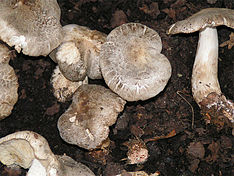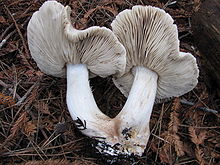- Tricholoma pardinum
-
Tricholoma pardinum 
Tricholoma pardinum Scientific classification Kingdom: Fungi Division: Basidiomycota Class: Agaricomycetes Order: Agaricales Family: Tricholomataceae Genus: Tricholoma Species: T. pardinum Binomial name Tricholoma pardinum
(Pers.) Quél. (1873)Synonyms[1] Agaricus myomyces var. pardinus Pers. (1801)
Tricholoma tigrinum
Gyrophila tigrina Schaeffer ex Quel.
Tricholoma tigrinis Schaeffer ex. Quel Tricholoma pardalotum Herink & Kotl. (1967)Tricholoma pardinum Mycological characteristics 
gills on hymenium 
cap is convex 
hymenium is free 
stipe is bare 
spore print is white 
ecology is mycorrhizal 
edibility: poisonous Tricholoma pardinum, commonly known as spotted tricholoma, tiger tricholoma, tigertop or dirty trich, is a gilled mushroom widely distributed across North America and Europe, as well as parts of Asia. It is generally found in beech woodland in summer and autumn. It is an imposing mushroom with a pale grey cap up to 10 cm (4 in) in diameter with darker brownish or greyish scales, white gills and white or pale grey-brown ringless stalk.
It is one of the more poisonous members of the genus Tricholoma and has been implicated in a number of episodes of mushroom poisoning, probably because it is a large, attractive mushroom with a superficial resemblance to a number of edible species as well as having a pleasant smell and taste. Ingesting T. pardinum even in small quantities causes a severe, persistent gastroenteritis due to the presence of an as yet unknown mycotoxin.
Contents
Taxonomy
Christiaan Hendrik Persoon described Tricholoma pardinum as Agaricus myomyces var. pardinus in 1801, though queried whether it was a distinct species.[2] French mycologist Lucien Quélet reclassified it as a species in 1873, giving it its current binomial name.[3] The specific epithet pardinum is derived from the Latin pardus 'leopard',[4] referring to its mottled or spotted cap.[5] The generic name derives from the Greek trichos/τριχος 'hair' and loma/λωμα 'hem', 'fringe' or 'border'.[6] It lies within the subgenus Pardinicutis within the genus Tricholoma.[7] Tricholoma tigrinum is a synonym of T. pardinum seen in some guidebooks,[8][9] but has been applied in error to this species.[7] Furthermore, Czech mycologists Josef Herink and František Kotlaba proposed in 1967 that both designations were incorrect, and proposed the new name T. pardalotum.[10]
Tricholoma pardinum var. filamentosum is a variety with a more fibrillose cap and stipe which was described by Alessio in 1983.[11] It is found in southern Europe.[7]
It is commonly known as striped tricholoma,[12] spotted tricholoma,[9] tiger tricholoma,[13] poison trich,[14] or tigertop.[15]Dirty trich was a name coined by author Gary H. Lincoff in response to a publisher's request for a more accessible name than its binomial one, for North American guidebooks.[16]
Description
The fruiting body is a medium-sized mushroom, with a cap 6–10 cm (2½–4 in) in diameter, though larger specimens occasionally reach 15 cm (6 in). The cap is initially hemispherical before flattening with maturity. It is silvery-grey and covered with concentrically-patterned darker scales of a grey, brown or blackish colour that grow paler toward the cap margin. The gills are free (unattached to the stipe), white and thick, may have a yellow or greenish tint, and may drip water, as may the top of the stalk when broken. The stout stalk may be white, pale grey or pale brown and is thicker at the base.[8] It is 3 to 8 cm high and 1.5 to 2 cm wide, with the base 2.5 to 4 cm in diameter, and turn a dirty yellowish colour when bruised.[7] There is no ring or volva. The flesh is whitish and has a pleasant mealy smell and taste.[8] The spore print is white, and the oval to oblong spores are 7.5–9.5 μm long by 5-7 μm wide.[7]
It may be confused with several edible grey-capped members of the genus Tricholoma, and some authorities recommend leaving all grey-capped Tricholoma species for the experienced mushroomers.[8] The smaller T. terreum lacks the mealy smell and cap scales, while T. orirubens has fine dark scales and pinkish gills.[17] The edible T. argyraceum is similar in appearance but with finer scales.[8] The edible and highly regarded T. portentosum is of a similar size, though has a uniform grey cap which is never scaled.[12] In North America, it can be confused with T. nigrum and T. virgatum which have more streaked rather than spotted caps.[5] A form of T.. pardinum in North America can be nearly white with pale scales, and confused with the whitish edible species T. resplendens.[13] Microscopically, the presence of clamp connections sets it apart from most other members of the genus, although the similar-looking (though more tan-coloured) T. venenatum also has them.[5]
Distribution and habitat
Tricholoma pardinum is found across Europe, where it is more common in the south.[7] It is abundant in the Jura Mountains in eastern France.[12] It is found in Belgium and Germany, but has not been recorded from the Netherlands,[7] or the British Isles.[9] A historical record from Estonia has been discarded.[18] In Asia, it has been recorded from İzmir Province in southwestern Turkey,[19] China,[20] and Sado Island in Japan.[21] It is found widely across temperate North America,[22] as far south as Santa Cruz County and Sierra Nevada in central California in the west of the continent,[23] and to the central Appalachians in the east.[24] It is commonly associated with conifers in the Rocky Mountains and Pacific Northwest, and with tanoak (Lithocarpus densiflorus) and madrone (Arbutus spp.) in California. It can be very abundant in some years, especially warmer years with higher rainfall,[25] yet missing or rare for several years in between.[13] In Europe, it is found on chalky soil in woodland with beech and fir in summer and autumn,[8] where it prefers areas of some elevation.[12] It may be found in groups or fairy rings.[12]
Toxicity
Tricholoma pardinum is one of several poisonous members of the genus Tricholoma; its large size, fleshy appearance, and pleasant smell and taste add to the risk of it being accidentally consumed. It was responsible for over 20% of cases of mushroom poisoning in Switzerland in the first half of the 20th century.[26] Many cases of poisoning arise in the Jura Mountains.[12] Eating it results in highly unpleasant gastrointestinal symptoms of nausea, dizziness, vomiting and diarrhea.[8] These arise 15 minutes to 2 hours after consumption, and may persist for 4–6 days. Sweating and anxiety may be evident, and disturbance in liver function has been recorded.[22] In one case, seven people and a cat suffered severe symptoms after sharing a meal with only two mushroom caps. The identity of the toxin is unknown.[27]
These symptoms may be severe enough to warrant hospitalization. Treatment is supportive; antispasmodic medicines may lessen colicky abdominal cramps and activated charcoal may be administered early on to bind residual toxin. Intravenous fluids may be required if dehydration has been extensive, especially with children and the elderly.[28] Metoclopramide may be used in cases of recurrent vomiting once gastric contents are emptied.[29]
References
- ^ "Tricholoma pardinum (Pers.) Quél. 1873". MycoBank. International Mycological Association. http://www.mycobank.org/MycoTaxo.aspx?Link=T&Rec=356853. Retrieved 2011-09-29.
- ^ Persoon, Christiaan Hendrik (1801). Synopsis Methodica Fungorum [Methodical Synopsis of the Fungi]. 2. Göttingen, Sweden. p. 346. http://www.librifungorum.org/Image.asp?ItemID=82&ImageFileName=0346b.jpg.
- ^ Quélet, Lucien (1873) (in French). Mémoires de la Société d’émulation de Montbéliard, Sér. 2. 5. p. 339.
- ^ Simpson, D. P. (1979). Cassell's Latin Dictionary (5 ed.). London, UK: Cassell Ltd. p. 423. ISBN 0-304-52257-0.
- ^ a b c Trudell, Steve; Ammirati, Joe (2009). Mushrooms of the Pacific Northwest. Timber Press Field Guide. Portland, Oregon: Timber Press. p. 106. ISBN 0881929352. http://books.google.com/books?id=WevHvt6Tr8kC&pg=PA106.
- ^ Nilsson, Sven; Persson, Olle (1977). Fungi of Northern Europe 2: Gill-Fungi. New York, New York: Penguin. p. 24. ISBN 0-14-063006-6.
- ^ a b c d e f g Bas, Cornelis; Noordeloos, Machiel Evert; Kuyper T. W., et al. (1999). Flora Agaricina Neerlandica. 4. Rotterdam, Netherlands: A.A. Balkema Publishers. pp. 148. ISBN 9054104937. http://books.google.com/books?id=QeRJnxAoRKoC&pg=PA148.
- ^ a b c d e f g Zeitlmayr,Linus (1976). Wild Mushrooms: An Illustrated Handbook. Hertfordshire, UK: Garden City Press. pp. 72–73. ISBN 0-584-10324-7.
- ^ a b c North, Pamela (1967). Poisonous Plants and Fungi in Colour. Blandford Press & Pharmacological Society of Great Britain. p. 110. OCLC 955264.
- ^ Herink, Josef; Kotlaba, František (1967). "Occurrence of the fungus Tricholoma tigrinum in Czechoslovakia and its correct name". Česká Mykologie 21 (11): 1–11.
- ^ Alessio, C. L. (1983). "Tricholoma pardinum var. filamentosum new variety". Micologia Italiana 12 (2): 15–21.
- ^ a b c d e f Lamaison, Jean-Louis; Polese, Jean-Marie (2005). The Great Encyclopedia of Mushrooms. Cologne, Germany: Könemann. p. 89. ISBN 3-8331-1239-5.
- ^ a b c Arora, David (1986). Mushrooms Demystified: A Comprehensive Guide to the Fleshy Fungi (2nd ed.). Berkeley, California: Ten Speed Press. p. 183. ISBN 0-89815-169-4.
- ^ Lincoff, Gary H. (2008). National Audubon Society Field Guide to North American Mushrooms. New York, New York: Alfred A. Knopf. p. 801. ISBN 0-394-51992-2.
- ^ Walderhaug, M. (1992). "Mushroom Toxins". Foodborne Pathogenic Microorganisms and Natural Toxins Handbook. USFDA/Center for Food Safety & Applied Nutrition. http://www.cfsan.fda.gov/~mow/chap40.html. Retrieved 2009-02-20.
- ^ Bakaitis, Bill (2003). "A Morel in the Bush, Worth a Tour in the Can?". Entelechy: Mind & Culture. Entelechy: Mind & Culture. http://www.entelechyjournal.com/morels.htm. Retrieved 2008-02-07.
- ^ Haas, Hans (1969). The Young Specialist looks at Fungi. London, UK: Burke. p. 144. ISBN 0-222-79409-7.
- ^ Kalamees, Kuulo (2010). "Checklist of the species of the genus Tricholoma (Agaricales, Agaricomycetes) in Estonia" (PDF). Folia Cryptogamica Estonica 47: 27–36. http://www.ut.ee/ial5/fce/fce47pdf/fce47_kalamees.pdf.
- ^ Solak, Mehmet; Işiloglu, M.; Gucin, F.; Gokler, I. (1999). "Macrofungi of Izmir Province" (PDF). Turkish Journal of Botany 23: 383–90. http://journals.tubitak.gov.tr/botany/issues/bot-99-23-6/bot-23-6-5-98025.pdf.
- ^ "An Annotated Checklist of Tricholoma from China" (in Chinese). Wanfang Data. http://d.wanfangdata.com.cn/Periodical_jwyj200401001.aspx. Retrieved 2009-02-20.
- ^ Miyauchi, Shinnosuke (1997). "A poisonous species, Tricholoma pardinum newly recorded in Japan". Nippon Kingakukai Kaiho 38 (2): 85–86.
- ^ a b Ammirati, Joseph F.; Traquair, James A.; Horgen, Paul A. (1985). Poisonous Mushrooms of the Northern United States and Canada. Minneapolis, Minnesota: University of Minnesota Press. pp. 328–29. ISBN 0-8166-1407-5.
- ^ Fuller, Thomas C.; McClintock, Elizabeth May (1986). Poisonous Plants of California. Berkeley, California: University of California Press. p. 54. ISBN 0520055691. http://books.google.com/books?id=0-op0XwlDmQC&pg=PA54.
- ^ Roody, William C. (2003). Mushrooms of West Virginia and the Central Appalachians. Lexington, Kentucky: University Press of Kentucky. p. 263. ISBN 0-8131-2262-7. http://books.google.com.au/books?id=5HGMPEiy4ykC&pg=PA263&dq=%22Mushrooms+of+West+Virginia+and+the+Central+Appalachians%22+pardinum&hl=en&ei=PTaYTs_YEKf0mAXK9rmHDA&sa=X&oi=book_result&ct=book-preview-link&resnum=1&ved=0CDQQuwUwAA#v=onepage&q&f=false.
- ^ Smith, Alexander Hanchett; Weber, Nancy S. (1980). The Mushroom Hunter's Field Guide. Ann Arbor, Michigan: University of Michigan Press. p. 157. ISBN 0472856103. http://books.google.com/books?id=TYI4f6fqrfkC&pg=PA157.
- ^ Alder, A. E. (1960). "Pilzvergiftung in der Schweiz während 40 Jahren [Mushroom poisoning in Switzerland over 40 years]" (in German). Schweizerische Zeitschrift für Pilzkunde 38: 65–73.
- ^ Benjamin, pp. 370–71.
- ^ Benjamin, pp. 354–55.
- ^ Benjamin, p. 188.
Cited texts
- Benjamin, Denis R. (1995). Mushrooms: Poisons and Panaceas – a Handbook for Naturalists, Mycologists and Physicians. New York, New York: WH Freeman and Company. ISBN 0-7167-2600-9.
- Miller, Orson K., Jr (1972). Mushrooms of North America. New York, New York: E. P. Dutton & Co., Inc. ISBN 0-525-16165-1.
External links
Categories:- Poisonous fungi
- Tricholomataceae
- Fungi of Europe
- Fungi of North America
- Fungi found in fairy rings
- Fungi described in 1873
Wikimedia Foundation. 2010.

